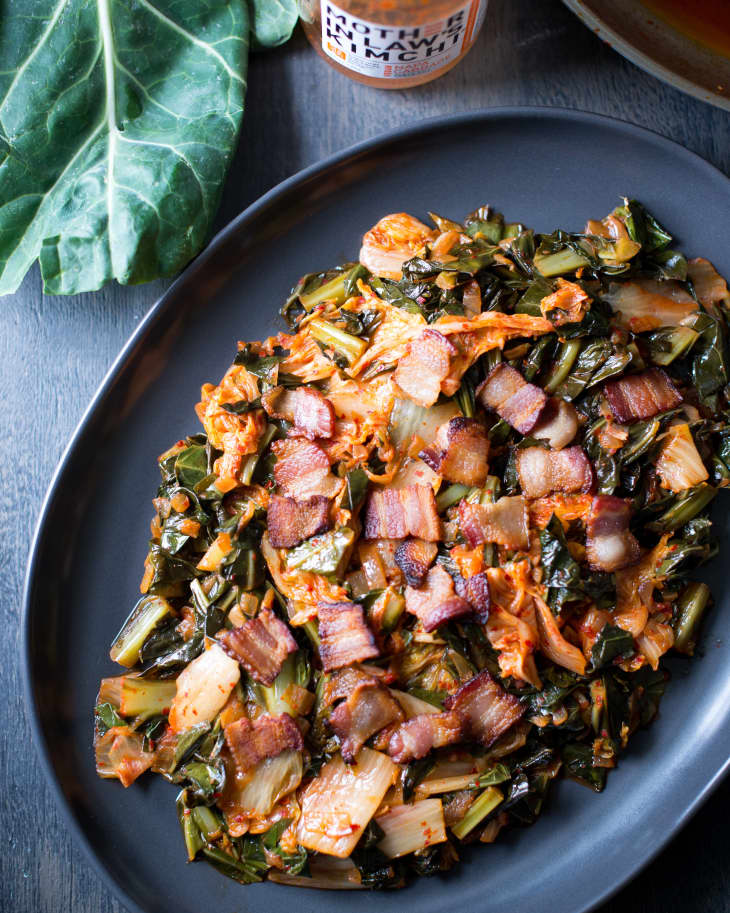Recipe: Collards and Kimchi

Fusion foods are created when ingredients, flavors, or a technique from one cuisine combine with those of another. I like to call these kinds of dishes “When Harry Met Sally” recipes. These recipes are born when you think two different things can’t possibly be friends because something will inevitably get in the way. But those two flavors keep bumping into each other (sometimes in your dreams) because — despite their differences — it’s just meant to be. And so you surrender to the union and everyone is happy in the end. History has proven that, perhaps, there’s no better type of fusion food than East meets West.
Think about it: Typical American food is content hanging out by himself, until one day he starts to seek excitement and adventure. A hot and spicy little condiment enters the room and — bam — sparks fly! Szechuan-sauced chicken wings, crab rangoon pizza, Thai-style hamburgers, meatloaf with sweet-and-sour Sauce — you’d hardly flinch when seeing these types of fusion recipes today on menus across the country, and you must admit: Your taste buds are intrigued.
Well then, you’ll be happy to learn there’s a new love story brewing. This one is between collard greens (classic American southern comfort) and kimchi (spicy Korean fermented vegetables). Strong and sturdy collards are one of the few greens destined for a long and slow simmer on the stovetop. The pieces are thin yet thick, and they readily welcome fat and other aggressive flavors without withering away into the background. In other words, they’re kind and adaptable, yet they still command a presence. When you turn on the heat, collards become perfectly tender without completely falling apart. Okay, wait a minute: Are we still talking about greens or did I just describe the perfect man? From here on forward, collards will be playing the part of Harry.
Kimchi enters stage left. She’s fermenting, remember, so we need to handle her with care. Most often a combination of napa cabbage and daikon radish, kimchi is a side dish or condiment (both, really) that is bold, complex, and spicy. She’s been bottled up in a jar for weeks, flowering into a desirable probiotic in the form of beneficial lactic acid that can balance and heal your digestive and urinary systems. She’s fiery, she’s deep, and she’s so ready to be free from her confines that sometimes she bubbles over at the first breath of fresh air (read: open the jar over a sink).
So who are you to stop this fusion? Consummate the marriage with some thick-as-you-can-get bacon (it’s my stand-in for the ham bone you’d find in traditional collard green recipes) and a few other pantry ingredients. Then sit back and enjoy the show. This one is so fated to be a classic that it just might bring tears to your eyes.
Collards and Kimchi
Serves 4 to 6
Nutritional Info
Ingredients
- 1 tablespoon
olive oil
- 5 slices
thick-cut bacon, cut into 1-inch pieces
- 1/2
medium sweet onion, peeled and diced
- 2 bunches
collard greens
- 2 tablespoons
apple cider vinegar
- 1 cup
low-sodium chicken or vegetable broth
- 1
(14-ounce) jar kimchi
Pinch of red pepper flakes (optional)
Instructions
Cook the bacon:
Heat the oil in a very large skillet (not nonstick) over medium-high until it shimmers. Add chopped bacon and cook until crisp around the edges, stirring occasionally with a wooden spoon. Remove bacon to a paper towel-lined plate and set aside. With bacon grease still in the skillet, add onion and sauté until softened, translucent, and nearly caramelized, 8 to 10 minutes.
Prepare the collards:
While the bacon and onion are cooking, stack a few collard leaves on a cutting board. Cut off stems and cut leaves crosswise into long. 1-inch wide strips. Cut strips into approximate 2-inch pieces. Repeat with remaining collard leaves (see Recipe Notes). Place collards in a colander or salad spinner and rinse under running water; spin or shake dry to remove most of the water. When onion is nearly caramelized, add collards, one handful at a time. Heat and stir until collards begin to cook down, about 2 minutes, then add another handful of collards. Repeat until all collards are added to the skillet.
Deglaze the pan:
Push collards to one side of the skillet to expose the browned bits (the fond) on the bottom of the pan. Add vinegar and quickly stir up the fond. Add broth, reduce heat to medium, and continue to cook collards, stirring occasionally, until almost all of the liquid is evaporated, 10 to 15 minutes. Meanwhile, open the jar of kimchi over the sink since fermented foods have a tendency to bubble over when opened.
When the liquid in the skillet has nearly all evaporated (and what liquid remains has turned golden-brown and thickened), remove skillet from heat. Add kimchi to ingredients in skillet and stir until well-mixed. If desired, stir in red pepper flakes. Transfer collards-kimchi mixture to a serving dish and top with the crisp bacon pieces. Serve warm.
Recipe Notes
Kimchi, or kimchee, is spicy pickled and fermented cabbage. Thanks to the recent and growing popularity of fermented foods and their health benefits, there are many brands and variations of kimchi available. A few of my favorites are those from Farmhouse Culture and Mother In Law's Kimchi. Of course, it's totally satisfying — and not that hard — to make your own kimchi at home.
You'll need 2 bunches, or about 12 large leaves, of collard greens. It is not necessary to remove the thick center rib of the collard leaves; it will cook down and help maintain some toothsome crunch. Do, however, remove and compost the thick round stems.
